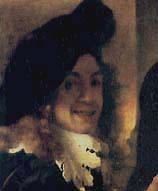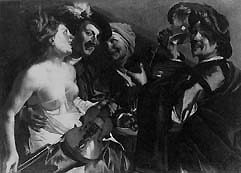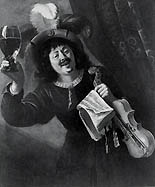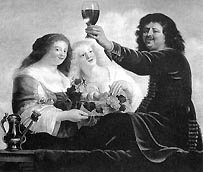The Procuress: Evidence for a Vermeer Self-Portrait
While the 1696 Dissius self-portrait remains lost or has been destroyed, the pose, the glance, the fancy costume, and the placement of the figure on the left of Vermeer's The Procuress (1656) all suggest this is the only extant supportable self-portrait (or any painter's portrait) of Vermeer, who was nearly twenty-four at the time. Although the smiling young man represented in this painting could have easily been a friend, relative or fellow painter, many scholars believe that Vermeer created an image of himself separately and inserted it rather awkwardly into the scene. There are compelling reasons in support of this conjecture:

The Procuress (detail)
Johannes Vermeer
The motif of the "merry company" or "prodigal son" was a popular theme among Dutch artists of the time, beginning with paintings by Van Couwenbergh and Rembrandt in the 1620s and extending through to Adriaen Brouwer and later works by Vermeer's contemporaries, Gabriel Metsu, Frans van Mieris, and Jan Steen. In many of these paintings, the convention was to depict the artist himself staring out at the viewer, usually at the edge of a crowd and often adorned in a beret or other exotic hat and fancy costume, typically wearing a sly smile, raising a glass as if in a toast, and holding a lute (or at least showing one nearby). See especially Rembrandt's The Prodigal Son (1636—in which Rembrandt chose to paint over a lute) and van Mieris' Charlatan (early 1650s).
In addition to this convention, which The Procuress honors with nearly every feature, there is the probability that Vermeer captured his likeness by studying it in a mirror. Walter Liedtke, in his Vermeer and the Delft School writes: "The angle of the head [of the figure on the left], the raised left (that is, right) hand, and the more arbitrary arrangement of the other arm are consistent with this reading. But more striking still is the handling of light in this area, which differs from that of the other figures and, as a result, makes it seem as if a mirror or mirror-like image has been inserted into a painting by one of Honthorst's Amsterdam or Delft admirers." While it is possible, of course, that Vermeer held his glass in his left hand for this painting because he was left-handed, the other visual evidence suggests he was actually holding it in his right hand but the mirror reversed the image.
There are other stylistic aspects of the young man's face which suggest a self-portrait. Specifically, its affinity with Rembrandt's 1629 Self-Portrait, among many others, with the face highlighted in one area by sunlight but otherwise blanketed in diffused shadow. Notice, too, the brightly colored wall behind the figure, a feature consistent with other self portraits but at odds with the rest of the visual imagery in The Procuress.

Self Portrait (detail)
Rembrandt van Rijn
If, as this evidence suggests, the leering young man is indeed a portrait of Vermeer, the image is remarkable for its lascivious humor and candid, auto-erotic sexuality. Vermeer may have painted the appearance of quiet, highly dignified genre scenes, but he was the son of a tavern owner who lived in a tavern through his formative years and who likely helped his mother run the establishment throughout most of his life. He also fathered fifteen children during twenty-three years of marriage. The portrait depicts a sensual man, a raconteur confidant of his skills and wit, who ultimately challenges the viewer with an inscrutably knowing countenance.
Jon Boone

Loose Company
Dirck van Baburen
1632

Merry Musician
Christiaen van Couwnbergh
1642

Man with a Wineglass and two
Women with a Fruitbasket
Christiaen van Couwenbergh
1647

